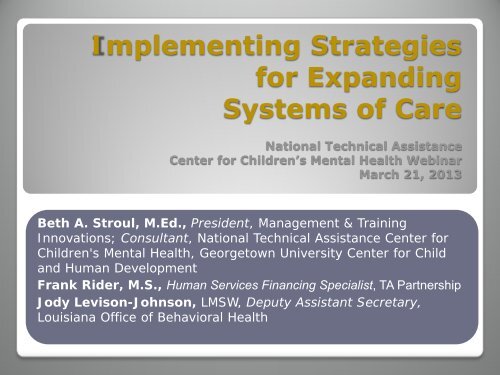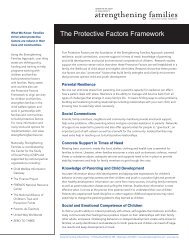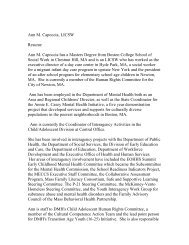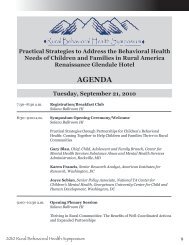Powerpoint Presentation (PDF) - National Technical Assistance ...
Powerpoint Presentation (PDF) - National Technical Assistance ...
Powerpoint Presentation (PDF) - National Technical Assistance ...
Create successful ePaper yourself
Turn your PDF publications into a flip-book with our unique Google optimized e-Paper software.
Implementing Strategies<br />
for Expanding<br />
Systems of Care<br />
<strong>National</strong> <strong>Technical</strong> <strong>Assistance</strong><br />
Center for Children’s Mental Health Webinar<br />
March 21, 2013<br />
Beth A. Stroul, M.Ed., President, Management & Training<br />
Innovations; Consultant, <strong>National</strong> <strong>Technical</strong> <strong>Assistance</strong> Center for<br />
Children's Mental Health, Georgetown University Center for Child<br />
and Human Development<br />
Frank Rider, M.S., Human Services Financing Specialist, TA Partnership<br />
Jody Levison-Johnson, LMSW, Deputy Assistant Secretary,<br />
Louisiana Office of Behavioral Health
Federal Children’s Mental Health<br />
Initiative (CMHI)<br />
• Established by Congress in 1992<br />
• As of FY 2011, funded 173 communities in 50 states, 21<br />
tribes, and 2 territories to implement the SOC approach<br />
• <strong>National</strong> evaluation of the CMHI and other studies have<br />
found:<br />
−Positive outcomes for children and families<br />
−Improvements in systems and services<br />
−Better investment of limited resources<br />
• Led to efforts to expand implementation of the<br />
approach so more children and families benefit
SAMHSA’s Theory of Change<br />
Innovation to Widespread Adoption
SAMHSA Support for<br />
Expanding the SOC Approach<br />
• Planning grants to support development of strategic plans to<br />
expand the SOC approach statewide and throughout tribes and<br />
territories<br />
• Implementation grants provide up to $1million per year for 4<br />
years to support implementation of the SOC approach<br />
• Planning and implementation strategies are relevant and<br />
applicable in any jurisdiction seeking to improve<br />
outcomes by expanding the system of care approach, with<br />
or without grant funding<br />
• Assumption for webinar is that some type of expansion<br />
plan (formal or informal) has been created
System of Care Expansion<br />
Implementation Logic Model
Preparation for System of Care<br />
Expansion Implementation Activities
Create or Improve System of<br />
Care (SOC) Implementation<br />
Team<br />
1. Create an SOC Implementation Team or modify an existing<br />
SOC-related team (e.g., SOC Planning Team)<br />
2. Use dimensions of and effective team as a guide<br />
• Embedded in system<br />
• Appropriate stakeholders based on goals<br />
• Individuals in decision making roles<br />
• Individuals with access to high-level policy makers<br />
• Family and youth voices<br />
• Representatives of culturally diverse populations<br />
• Individuals with needed expertise (e.g., social marketing,<br />
evaluation, financing)
SOC Implementation Team (continued)<br />
3. Ensure composition of team includes appropriate<br />
leaders and stakeholders<br />
• Leaders who are leading/managing implementation<br />
• Family and youth leaders<br />
• Representatives from partner systems<br />
• Designated leads for cultural and linguistic competence, social<br />
marketing, evaluation<br />
• Service providers<br />
• Other stakeholders important to SOC expansion
SOC Implementation Team (continued)<br />
4. Obtain official sanction for team<br />
• Structure and role<br />
• Mandate for widespread SOC implementation<br />
• Executive order, memorandum of<br />
understanding (MOU), legislation<br />
5. Link team with high-level policy and<br />
decision makers<br />
• Assess existing policy structures to link with<br />
• Establish a process for SOC Implementation<br />
Team to link with and report to high-level<br />
decision and policy makers
Review and Clarify Previously<br />
Developed SOC Expansion Plan<br />
1. Review previously developed strategic plan for SOC<br />
expansion<br />
• Briefly review strategic SOC expansion plan<br />
• Briefly review social marketing plan and/or goals<br />
• Ensure all team members are familiar with goals and strategies<br />
2. Clarify or refine areas of plan if necessary (minor<br />
refinements)<br />
• Make minor clarifications or refinements needed for<br />
implementation − avoid returning to planning phase!
Clarify Overall Expansion Strategy<br />
1. Overall approach to expansion<br />
• Geographic<br />
• By level of need population (e.g., most high-need children)<br />
• Age band<br />
• Funding eligibility<br />
• Service sector<br />
• Other<br />
2. Population of focus
Polling Question #1:<br />
Our jurisdiction has selected, as its primary approach to SOC expansion:<br />
___ Expand geographically (e.g., adding more and more communities/<br />
counties over time)<br />
___ Expand by level of need (e.g., start with young people with highest<br />
needs, then add those with moderate needs, then with lower needs)<br />
___ Expand by age level (e.g., early childhood, then school aged, then<br />
adolescent)<br />
___ Expand by funding eligibility groups (e.g., begin with Medicaid<br />
enrollees, then CHIP enrollees, then state-funded, then privately<br />
insured)<br />
___ Expand by service sector (e.g., begin with youth in juvenile justice<br />
system, then add child welfare, then special education)<br />
___ Other expansion approach (please share with us during Q&A break)
Priority Goals<br />
3. Select high-priority goals for initial action<br />
• Must be accomplished first logically<br />
• Likely to have the biggest impact<br />
• Have high probability of success to demonstrate progress<br />
• Are likely to provide data to demonstrate positive outcomes of<br />
SOC approach<br />
• Might take the most time and effort<br />
• Build on timely opportunities in environment to support<br />
expansion goals<br />
• Support interagency partner outcomes or initiatives
Financing Plan and Service<br />
Delivery Plan<br />
4. Develop or refine financing plan<br />
• Review financing strategies in previously developed plan<br />
• Ensure financing strategies to achieve goals<br />
• Create financing strategies where none are already specified<br />
• Develop financing plan detailing financing strategies to achieve<br />
goals<br />
5. Develop or refine plan for delivering<br />
services in achieving SOC expansion goals:<br />
• What services<br />
• What population<br />
• What areas of jurisdiction
Implementation of System of<br />
Care Expansion Activities
Review and Improve Factors<br />
that Affect Implementation<br />
1. Realistic goals<br />
2. High-priority goals<br />
3. Specific, concrete<br />
strategies<br />
4. Strong leadership to<br />
manage implementation<br />
5. Commitment of highlevel<br />
policy and decision<br />
makers<br />
6. Cross-agency<br />
partnerships<br />
7. Commitment across key<br />
stakeholders<br />
8. Staff and resources<br />
allocated to<br />
implementation work<br />
9. Opportunities for<br />
expansion in<br />
environment
Implementation Strategies<br />
in Five Core Strategy Areas<br />
1. Implementing Policy, Administrative, Regulatory<br />
Changes<br />
2. Developing or Expanding Services and Supports<br />
Based on the SOC Philosophy and Approach<br />
3. Creating or Improving Financing<br />
Strategies<br />
4. Providing Training, TA, and Coaching<br />
5. Generating Support
Policy, Administrative, and Regulatory<br />
Changes<br />
• Organizational locus of accountability for SOCs (state and local)<br />
• Interagency structures, agreements, and partnerships for<br />
coordination and financing<br />
• Rules, regulations, guidelines, standards, and practice protocols<br />
• SOC requirements in requests for proposals and contracts<br />
• Legislation that supports the system of care approach<br />
• SOC approach in monitoring protocols<br />
• SOC approach into data systems for outcome measurement and<br />
quality improvement<br />
• Linking with and building on other system change<br />
initiatives (e.g. health reform, parity legislation,<br />
reforms in other systems, grant programs, and<br />
reform initiatives)
Expanding Services<br />
and Supports<br />
• Array of home- and community-based services and supports<br />
• Individualized, wraparound approach to service delivery<br />
• Care management entities<br />
• Care coordination and care management<br />
• Family-driven, youth-guided services involvement<br />
• Provider network with new providers and by retooling<br />
• Evidence-informed and promising practices and practice-based<br />
evidence approaches<br />
• Cultural and linguistic competence of services<br />
• Racial, ethnic, and geographic disparities in service delivery<br />
• Use of technology (e.g., electronic medical records, telemedicine,<br />
videoconferencing, e-therapy)
Financing Strategies<br />
• Medicaid<br />
• Federal system of care grants, Mental Health Block Grants, and<br />
other federal grants<br />
• Redeploying funds from higher cost to lower cost services<br />
• Case rates or other risk-based financing<br />
• State mental health and substance use funds<br />
• Funds from other child-serving systems<br />
• Local funds<br />
• Use of federal entitlements other than Medicaid<br />
• New financing structures and funding streams (e.g., health reform)<br />
• Informal resources (e.g., the assets of young people, families,<br />
informal supports, community organizations and institutions)
Intersect Between Health<br />
Reform and Systems of Care<br />
• Offers tested models for many ACA provisions to address unique<br />
needs of children with behavioral health challenges – Essential<br />
benefits for Medicaid and Health Insurance Exchanges, Medicaid<br />
and CHIP expansion, health homes, 1915(i) state plan amendments,<br />
Money Follows the Person, ACOs<br />
• Systems of care and their care management entities can be health<br />
homes – Improve quality and manage costs for populations with<br />
serious disorders, provide intensive care management, individualize<br />
care, link to needed services and supports across systems<br />
Wotring & Stroul, Pires et al – Center for Health Care Strategies
Polling Question #2:<br />
At this point, my jurisdiction’s financing strategies<br />
to support our SOC expansion initiative are:<br />
___ Developed and clear and are already being carried<br />
implemented.<br />
___ Moderately well developed, and we are making<br />
steady progress to develop our financing plan.<br />
___ Incomplete − We have defined some strategies, and<br />
we have much more work to do to complete a<br />
strategic financing plan.<br />
___ On our “to do” list, but we have not yet begun to<br />
focus on the financing strategies.<br />
___ Unclear to me, or I do not know.
Training, <strong>Technical</strong> <strong>Assistance</strong><br />
(TA), and Workforce Development<br />
• Training, TA, and coaching on the SOC approach<br />
• Ongoing training and TA capacity, including modification of<br />
existing training and TA structures or processes to align with<br />
the SOC approach or create new structures and/or processes<br />
• Training, TA, and coaching on evidence-informed and<br />
promising practices and practice-based evidence approaches<br />
• Strategies to prepare future workforce to work within SOC<br />
framework
Generating Support Through<br />
Social Marketing and Strategic<br />
Communications<br />
• Establishing strong family and youth organizations to support SOC<br />
expansion<br />
• Generating support among high-level policy makers and<br />
administrators at state and local levels<br />
• Data on outcomes and cost avoidance to promote SOC expansion<br />
• Partnerships with providers, provider organizations, managed care<br />
organizations, and other key leaders<br />
• Social marketing and strategic communications directed at key<br />
audiences<br />
• Cultivating leaders and champions for the system of care approach<br />
• Re-evaluating social marketing goals and audiences at regular<br />
intervals to ensure alignment with implementation goals
Infusing SOC Values into<br />
Implementation Activities<br />
• Family-driven, youth-guided approaches to services and<br />
systems<br />
• Cultural and linguistic competence in services and<br />
systems<br />
• Cross-system collaboration in services and systems
Embedding Systemic Changes to<br />
Ensure Sustainability Over Time<br />
• Review each strategy during implementation process to<br />
assess its sustainability over time<br />
• Embed and “institutionalize” strategies in policy and<br />
practice at the system and service delivery levels to<br />
ensure sustainability<br />
• Identify elements of the SOC expansion plan that<br />
partners can invest in and take a leadership role in<br />
implementing
CORE STRATEGIES NEEDED TO ACHIEVE GOAL<br />
GOAL IN STRATEGIC<br />
PLAN<br />
Implementing Policy,<br />
Administrative, and<br />
Regulatory Changes<br />
Developing Services and<br />
Supports Based on the<br />
SOC Approach<br />
Creating Financing<br />
Mechanisms<br />
Providing Training,<br />
<strong>Technical</strong> <strong>Assistance</strong><br />
(TA), and Coaching<br />
Generating Support<br />
through Strategic<br />
Communication<br />
GOAL #1:<br />
To expand SOC<br />
approach statewide<br />
(including state and<br />
local infrastructure<br />
and services) for<br />
youth and young<br />
adults of transition<br />
age (Y/YAT)<br />
Sub-Strategies: Sub-Strategies: Sub-Strategies: Sub-Strategies: Sub-Strategies:<br />
• Examine local<br />
infrastructure, identify<br />
strategy to improve<br />
management and<br />
accountability<br />
• Develop standard<br />
service delivery<br />
protocols for Y/YAT<br />
across systems<br />
• Develop policies and<br />
protocols for improving<br />
transition from youth to<br />
adult services<br />
• Develop contract<br />
language for new types<br />
of providers<br />
• Link with state’s<br />
integrated health care<br />
policy transformation<br />
• Identify new services<br />
and supports needed to<br />
effectively serve Y/YAT<br />
(e.g., supported housing<br />
and education)<br />
• Identify appropriate<br />
evidence-informed<br />
practices for Y/YAT<br />
• Develop a provider<br />
network with skills to<br />
serve Y/YAT effectively<br />
• Identify new types of<br />
providers needed<br />
• Develop peer support<br />
services<br />
• Design “Resiliency to<br />
Recovery” Continuum<br />
• Participate in state’s<br />
long-term planning for<br />
Medicaid and align goals<br />
• Explore Medicaid<br />
expansion to develop<br />
“Bridget” benefit at age<br />
18<br />
• Develop strategies for<br />
Medicaid financing of<br />
new services for Y/YAT<br />
• Design core<br />
competencies for<br />
traditional and<br />
nontraditional providers<br />
across agencies<br />
• Develop and provide<br />
training in evidencebased<br />
practices and<br />
promising practices for<br />
serving Y/YAT<br />
• Create social marketing<br />
and social inclusion<br />
plan<br />
• Create Youth Advisory<br />
Board and Youth<br />
Empowerment<br />
Program<br />
How to Tailor the Strategic Framework
Outcomes of System of Care<br />
Expansion
Values and Principles<br />
1. SOC values and principles are implemented<br />
• Individualized, wraparound approach<br />
• Family-driven approach<br />
• Youth-guided approach<br />
• Coordinated approach<br />
• Culturally and linguistically competent approach<br />
• Evidence-informed approach<br />
• Least restrictive approach<br />
• Broad array of home and community-based services<br />
• Data-driven continuous quality improvement and accountability<br />
approaches
Services and Supports<br />
2. Services and supports consistent with SOC approach<br />
are implemented<br />
• Availability of specific services and supports provided in SOCs<br />
(non-residential)<br />
• Availability of out-of-home treatment services for short-term<br />
treatment goals that are linked to home- and community-based<br />
services and supports
Infrastructure<br />
3. SOC infrastructure is implemented<br />
• Point of accountability structure for SOCs<br />
• Financing strategies for SOC infrastructure and services<br />
• Structure/processes to manage care for high-need populations<br />
• Interagency partnerships/agreements<br />
• Structure/processes for partnerships with family organizations/leaders<br />
• Structure/processes for partnerships with youth organizations/leaders<br />
• Structure/processes to advance culturally and linguistically competent<br />
services<br />
• Defined access/entry points to care<br />
• Sufficient provider network to deliver comprehensive service array<br />
• Structure/processes for training, TA, and workforce development<br />
• Structure/processes for measuring and monitoring quality, outcomes,<br />
and costs and using data for continuous quality improvement<br />
• Structure/processes for strategic communications/social marketing<br />
• Structure/process for strategic planning and identifying and resolving<br />
barriers
Resource Investment<br />
4. Resources are invested in home- and communitybased<br />
services<br />
• Increased utilization of home- and community-based services and<br />
supports<br />
• Decreased admissions and lengths of stay in out-of-home treatment<br />
settings (e.g., psychiatric hospitals, residential treatment centers,<br />
juvenile justice placements, out-of-school placements)<br />
• Cost data demonstrating impact on costs across systems by utilizing<br />
home- and community-based services and supports
Children Served in SOCs<br />
5. Services and supports are provided to increasing<br />
numbers of children with the SOC approach<br />
• Identification of areas within the jurisdiction that have high levels of<br />
SOC implementation<br />
• Increased number and description of children with serious<br />
mental/behavioral health challenges and their families served with the<br />
SOC approach within the jurisdiction
Development of a<br />
Rating Tool<br />
• Developed at request of CAFB as method to assess<br />
progress in SOC expansion<br />
• Built on previous methods, particularly national evaluation<br />
− <strong>National</strong> Evaluation System-Level Assessment,<br />
Sustainability Study, Study on Strategies for Expanding the<br />
SOC Approach<br />
• Developed draft tool with input and pilot tested<br />
• Revised and streamlined tool based on pilot and feedback<br />
• Adaptation for tribes underway with NICWA collaboration
Purpose<br />
• To assess progress in implementing the SOC<br />
approach<br />
• Provides “snapshot” of implementation of key elements of<br />
the SOC approach at a point in time<br />
• Method to derive an estimate of the “level” of<br />
implementation of the SOC approach<br />
• Identify areas of strength and areas needing<br />
improvement<br />
• Use at regular intervals to track progress (annually<br />
suggested)
Levels of<br />
Implementation<br />
Level 1 – Little or No Implementation<br />
Level 2 – Some Implementation<br />
Level 3 – Moderate Implementation<br />
Level 4 – Substantial Implementation<br />
Level 5 – Extensive Implementation
Uses of Information<br />
Community or Regional Level<br />
• Measure progress in SOC implementation<br />
• Identify areas needing attention while implementing the SOC approach<br />
State, Tribal, Territorial Level<br />
• Assess progress in implementing SOCs in multiple areas throughout<br />
jurisdiction to measure outcomes of expansion efforts<br />
• Baseline and subsequent ratings of progress in communities or regions<br />
• Communities or regions complete tool at regular intervals, state<br />
determines % of communities or regions at each of the 5 levels of<br />
implementation<br />
• Assess all jurisdictions or a subset depending on expansion approach<br />
• Annual use provides rough measure of progress based on comparison<br />
of % at each level year to year
Respondents<br />
• Designed for approximately 5+ respondents<br />
per community or region – scores are<br />
averaged<br />
• Can be customized to each community re number and<br />
type of respondent<br />
−Local Community- or Regional-Level Director or Manager of<br />
Services for Children with Behavioral Health Challenges<br />
−Lead Provider Agency Director or Manager<br />
−Family Organization Director or Family Leader<br />
−Youth Organization Director or Youth Leader<br />
−Local Community- or Regional-Level Director or<br />
Manager of Services for Children with Behavioral Health<br />
Challenges from a Partner Agency<br />
−Other Key Stakeholders Identified by Lead Contact Person<br />
for a Community or Region
State, Tribal, or Territory Report<br />
STATE :<br />
DATE:<br />
LEAD CONTACT PERSON WITH CONTACT INFORMATION:<br />
TOTAL NUMBER OF COMMUNITIES OR REGIONS:<br />
NUMBER OF COMMUNITY-LEVEL REPORTS:<br />
LEVEL OF SOC IMPLEMENTATION<br />
SCORES<br />
#<br />
Communities<br />
or Regions<br />
%<br />
Communities<br />
or Regions<br />
LEVEL I:<br />
LITTLE OR NO IMPLEMETATION<br />
(0 – 80)<br />
LEVEL II: SOME IMPLEMENTATION<br />
(81 – 160)<br />
LEVEL III: MODERATE IMPLEMENTATION<br />
(161 – 240)<br />
LEVEL IV: SUBSTANTIAL IMPLEMENTATION<br />
(241 – 320)<br />
LEVEL V: EXTENSIVE IMPLEMENTAITON<br />
(321 – 400)
LEVEL OF SOC IMPLEMENTATION PROGRESS REPORT<br />
LEVEL OF SOC IMPLEMENTATION<br />
SCORES<br />
% Communities or Regions<br />
Year 1 Year 2 Year 3 Year 4 Year 5<br />
LEVEL I:<br />
LITTLE OR NO<br />
IMPLEMENTATION<br />
LEVEL II: SOME IMPLEMENTATION<br />
LEVEL III: MODERATE<br />
IMPLEMENTATION<br />
LEVEL IV: SUBSTANTIAL<br />
IMPLEMENTATION<br />
LEVEL V: EXTENSIVE<br />
IMPLEMENTATION<br />
LEVEL OF SOC IMPLEMENTATION<br />
SCORES
Performance Assessment
Assess Progress with<br />
Implementation Activities<br />
• Completion of implementation activities<br />
−Collect performance data on completion of activities<br />
−Track and monitor progress in implementing expansion strategies<br />
−Track and monitor barriers<br />
−Develop strategies to overcome barriers<br />
−Refine activities to implement expansion strategies as necessary<br />
• Analyze progress and barriers<br />
• Improve implementation strategies and activities based<br />
on analysis of progress
To improve behavioral health outcomes for children,<br />
youth, and young adults with serious emotional<br />
disturbances and their families through widespread<br />
expansion of systems of care<br />
Overall Purpose of System of<br />
Care Expansion
Assess Outcomes for Children, Youth,<br />
and Young Adults who are Served<br />
with the SOC Approach<br />
• Establish set of key outcome indicators<br />
• Target indicators to generate data to support SOC expansion<br />
• Collect data<br />
• Identify areas needing improvement and improve services<br />
• Consider small set of key outcomes indicators:<br />
Lives within a family context<br />
Stable living arrangement<br />
Improved mental health (reduced<br />
symptomatology)<br />
Reduced/avoided substance<br />
use/abuse<br />
Successful in education settings<br />
Successful in employment<br />
Avoided crime and delinquency<br />
Avoided hospitalization, residential<br />
treatment<br />
Avoided suicidality, self-harm
Bruce D. Greenstein<br />
Secretary<br />
Implementing Strategies for Expanding Systems of Care<br />
The Louisiana Experience<br />
Jody Levison-Johnson – Office of Behavioral Health
Planning, planning and more planning…<br />
• Multi-year process<br />
• Many (many) workgroups<br />
• Use of consultants/experts<br />
• Began as Coordinated System of Care (CSoC),<br />
focusing on children with significant behavioral<br />
health challenges who are multi-system involved<br />
and in or at risk of out-of-home placement<br />
47<br />
dhh.la.go
Planning, planning and more planning…<br />
• Broadened to include:<br />
– Other (non-CSoC) children’s mental health services<br />
– Addiction services for children and adults<br />
– Adult mental health services<br />
• Required Request for Proposals (RFP) and<br />
Request for Information (RFI)<br />
– RFP for Statewide Management Organization<br />
– RFI for CSoC Phase I Implementation Regions<br />
48<br />
dhh.la.go
dhh.la.go<br />
Implementing the Louisiana Behavioral Health Partnership<br />
What is the LBHP?<br />
The umbrella behavioral health managed care program:<br />
– Coordinated System of Care (CSoC)<br />
– Children’s behavioral health(Including State<br />
Plan/EPSDT & Non-CSoC)<br />
– Adult behavioral health (including 1915(i) SPA and<br />
services)
Foundation for implementation<br />
Hodges, S., Israel, N., Ferreira, K., & Mazza, J. (2007). System<br />
implementation issue brief #2—Critical Factors in System of Care<br />
Implementation. Tampa: University of South Florida, Louis de la<br />
Parte Florida Mental Health Institute, Research and Training Center<br />
for Children’s Mental Health.<br />
Stroul, B. A., & Friedman, R. M. (2011). Issue brief: Strategies for<br />
expanding the system of care approach. Washington, DC: <strong>Technical</strong><br />
<strong>Assistance</strong> Partnership for Child and Family Mental Health.<br />
50<br />
dhh.la.go
Hodges et al.<br />
• Values and beliefs shift the mindset of the<br />
system<br />
• Goals enable action<br />
• Collaborative structures support local system of<br />
care implementation<br />
• Information facilitates system responsiveness<br />
51<br />
dhh.la.go
Some key implementation activities<br />
• Governance Board<br />
– Finance & Audit Committee<br />
– Quality Assurance Committee<br />
• Memorandum of Understanding<br />
– State Team<br />
– Funding<br />
• State Plan Amendments and Waivers<br />
• Regionally based Wraparound Organizations (WAAs),<br />
Family Support Organization Staff (FSO) and<br />
Community Teams<br />
52<br />
dhh.la.go
Some key implementation activities<br />
• Partner outreach and training<br />
– “Systems of Care are About…” framework<br />
– Referral Processes<br />
– Service array<br />
• Workforce development<br />
– WAAs and FSO staff<br />
– Other providers<br />
• Clearly defined process and outcome measures<br />
53<br />
dhh.la.go
Some takeaways<br />
• Cooperative agreement funding is not required<br />
• Journey not a destination<br />
• Act with intentionality<br />
• Anticipate and plan for challenges<br />
• Commit to ongoing Continuous Quality<br />
Improvement<br />
54<br />
dhh.la.go
Presenter Contact Information<br />
Frank Rider, M.S.<br />
American Institutes for Research<br />
frider@air.org<br />
(919) 896-8309<br />
Beth Stroul, M.Ed.<br />
Management & Training Innovations;<br />
<strong>National</strong> TA Center, Georgetown University<br />
bstroul@mtiworld.com<br />
(703) 448-7570<br />
Jody Levison-Johnson, LMSW<br />
Louisiana Office of Behavioral Health<br />
Jody.Levison@la.gov<br />
(225) 342-5921













